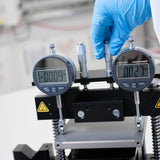How to Optimize Your Mayer Bar Coating Process

There are plenty of ways that you can optimize your bar coating process. Some of the main ways include:
- Changing Mayer rod
- Changing solution concentration and viscosity
- Optimizing bar speed
Below is a series of films made with different Mayer bars and differet concentrations. This clearly shows this can have an impact on film thickness and quality.

Changing Mayer Bar
The first thing to optimize when bar coating is to choose which Mayer rod or Mayer bar that you are using. Changing the Mayer bar will change the amount of solution allowed through the coating gap, affecting the coating thickness.
Choosing the right Mayer bar is the main way to determine wet film thickness in bar coating. In the images below, you can see that films of the same concentration look thicker when coated with a 120 μm bar compared to 10 μm bar.


However, this is not to say that 10 μm Mayer bar will make a 10 μm thick film. The Mayer bar will determine the wet film thickness of your film, not the final film thickness. This explains why the films made from more dilute films look thinner, even when using the same Mayer Rod.
Solution Concentration and Viscosity
The amount of solute in will also impact the dry film thickness. An approximate relationship for this states that:
Therefore more concentrated, viscous solutions lead to a thicker film, as seen in the image below.


As well as coating thickness, solution viscosity can have other influences on your bar coating process.
- The relationship and miscibility between the solutes and solvents will effect the amount of defects your film.
- Changing the viscosity of your solution will affect spreading and wettability of the solution on your substrate.
- Increased viscosity will mean less spreading, making it easier to control coating width.
- Increased viscosity will also mean solution may have a harder time filling small coating gaps, especially in thinner Mayer rods. This could lead to inconsistent films, and you may need to use a slower bar coating speed.
- Depending on your solution properties, solution viscosity can also affect the impact of capillary forces on your bar coating process.
Bar coating is not an ideal deposition method if your solutions are especially high or low viscosity.
Bar Speed
In bar coating, deposition speed will not have as big an impact on film properties as it does in other coating techniques such as slot die coating. However, it will have an impact, especially if you want tight control over your film quality, film thickness or to produce uniform films consistently. You will need to ensure that the bar moves slowly enough that enough material can flow easily through the coating gaps. If you drag the bar too fast, this may cause defects across your film.
Increasing bar speed can decrease film thickness, as the solution will have less time to get through the coating gaps.
However, if Capillary number of a solution is sufficiently low (Ca<<1), then capillary forces will have a bigger impact on the bar coating process. In this case, increased bar speed can increase film thickness.
Bar speed can be difficult to control by hand. In some cases, this doesn't need to be precisely controlled, and hand held bar coating is fine.

However, in cases where you need to consistently produce replicable films of consistent thicknesses, or for large area processing, it is a good idea to standardize all aspects of the bar coating process. Automated bar coater systems will standardize the movement of Mayer bars, to ensure that you produce the same film consistency every time.
Bar Coater

More Resources
Thin films can be created through a range of coating methods including evaporation techniques and solution processing methods. Solution processing techniques uniformly coat a substrate with a solution, which then dries to make a thin film. Uniform and reliable thin film deposition is essential for the development and manufacture of solar cells and organic light emitting diodes, or other semiconductor devices.
Read more... Bar Coating: Methods, Theory and Applications
Bar Coating: Methods, Theory and Applications
Bar coating is a simple wet processing technique used to deposit a thin layer of solution onto a substrate. It involves a bar being placed above a substrate and dragged over a pool of fluid, resulting in the fluid being spread into a thin film or coating. Bar coating is commonly used in the development of applications such as automotive paints, photovoltaic cells and lithium ion batteries.
Read more...